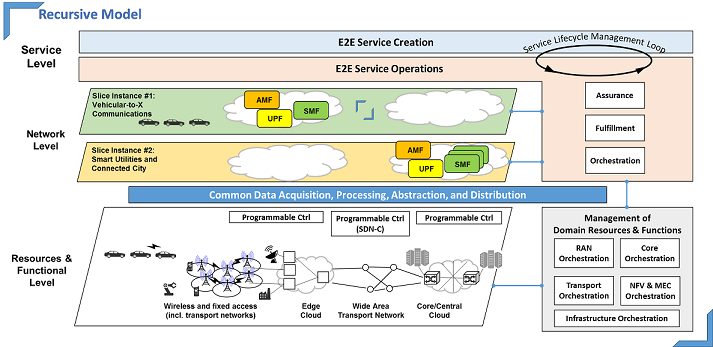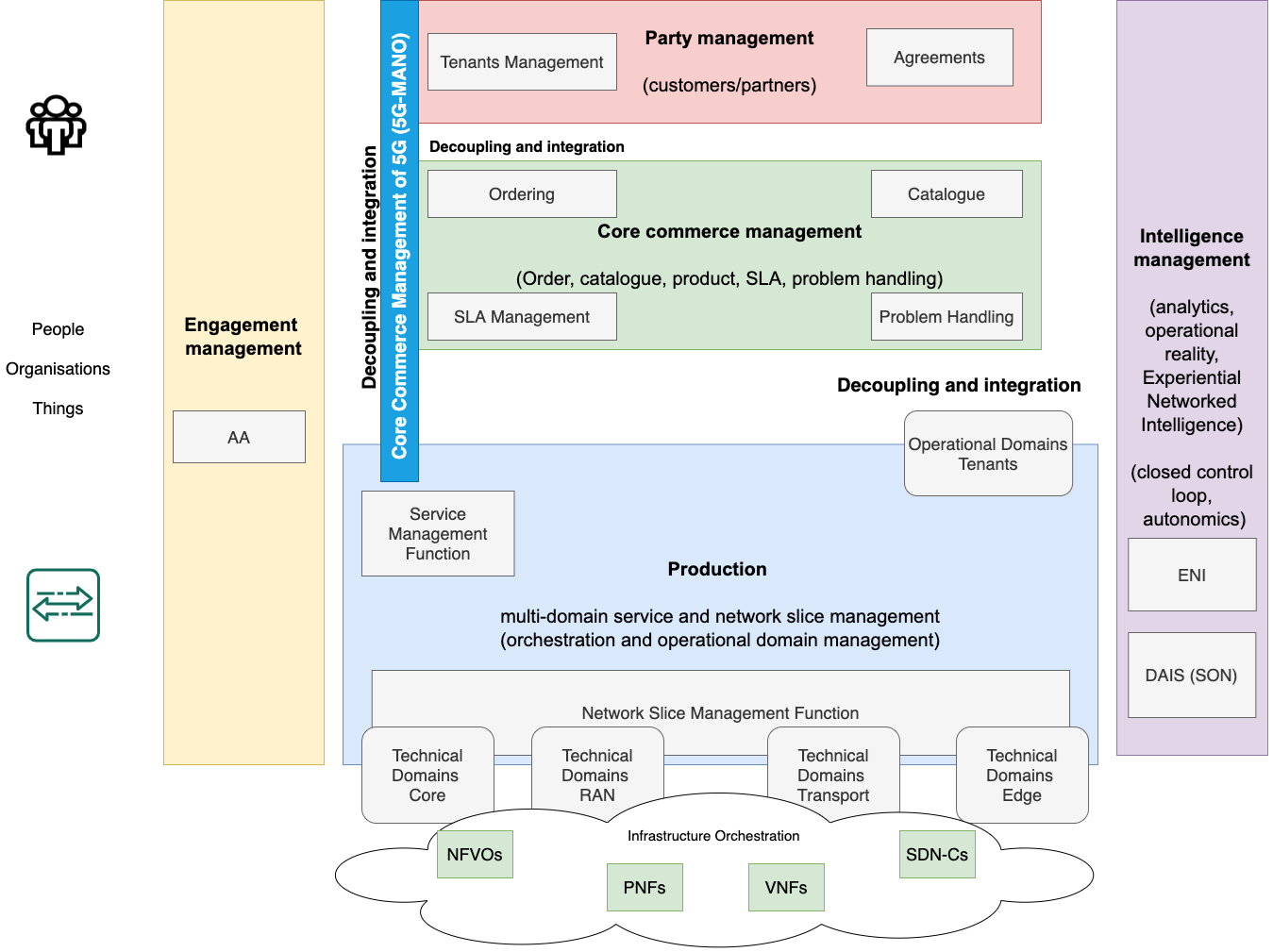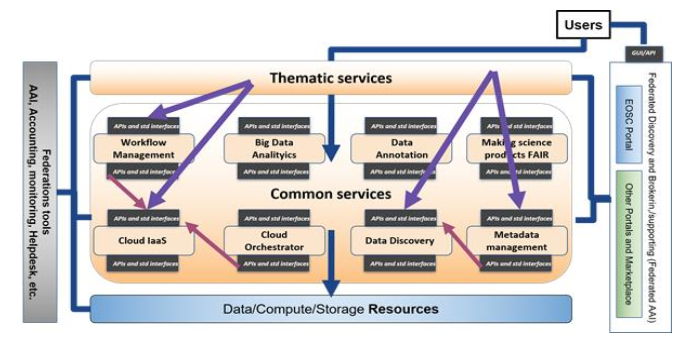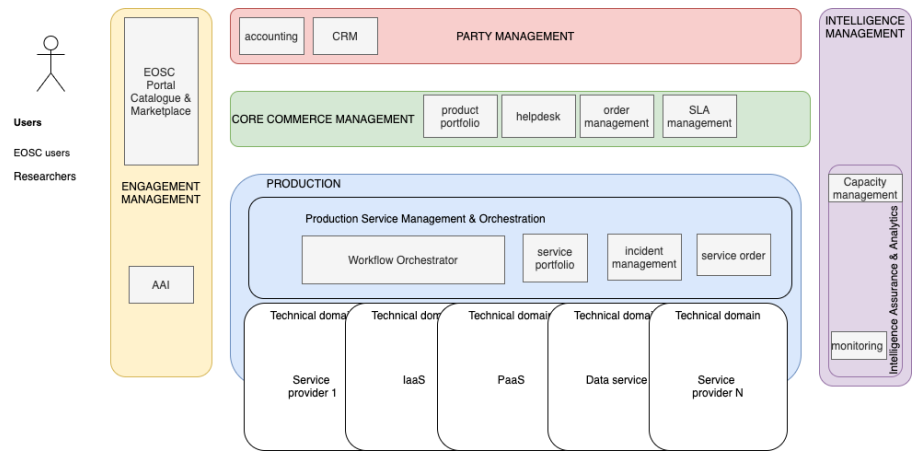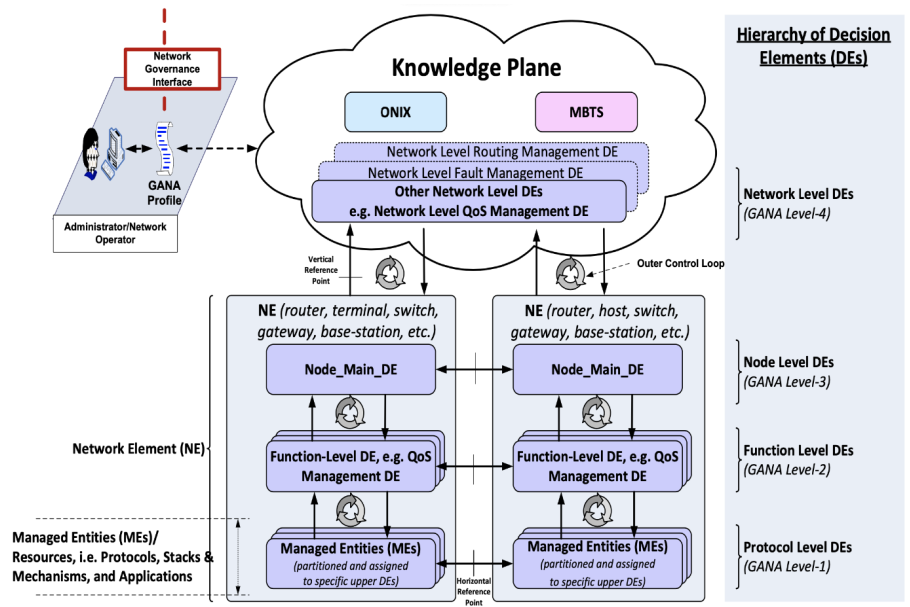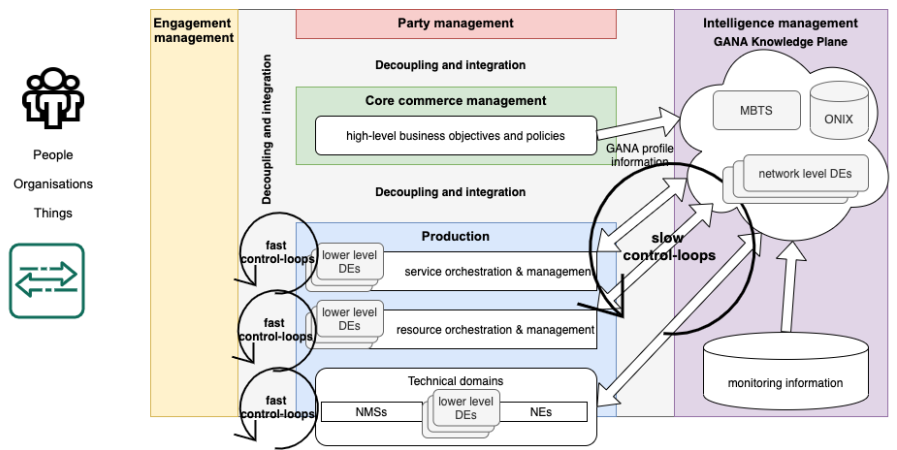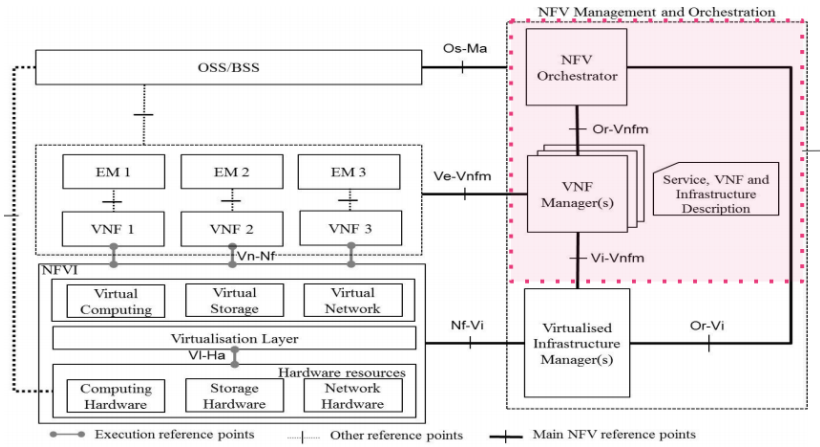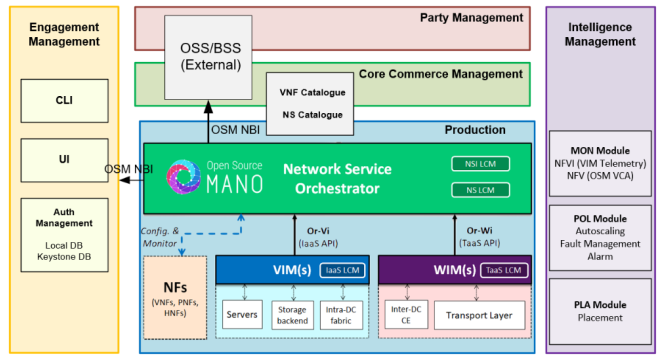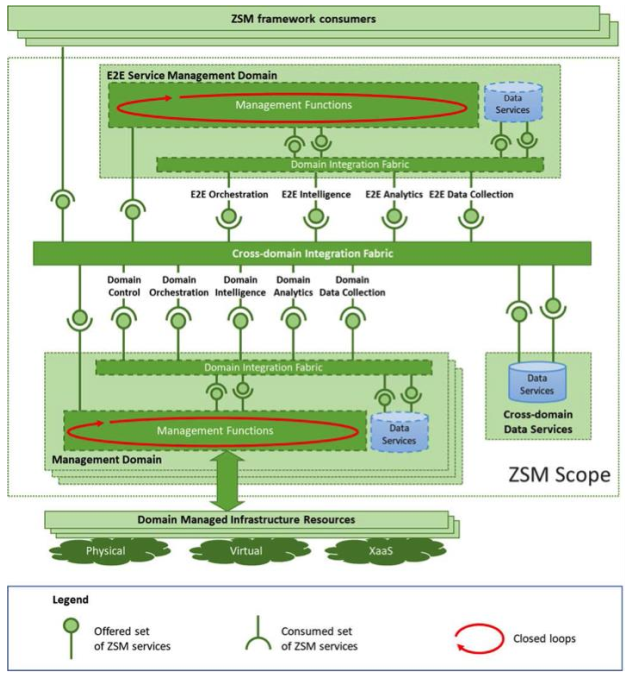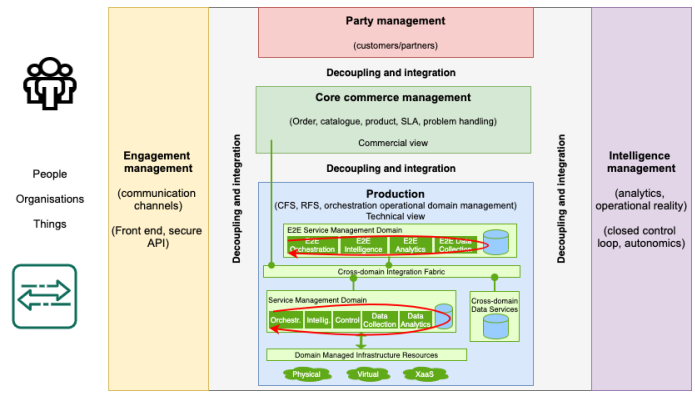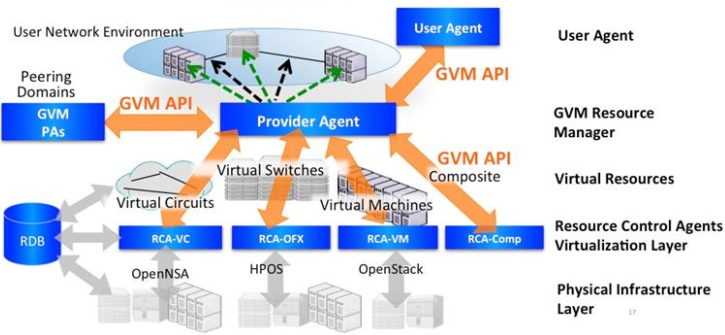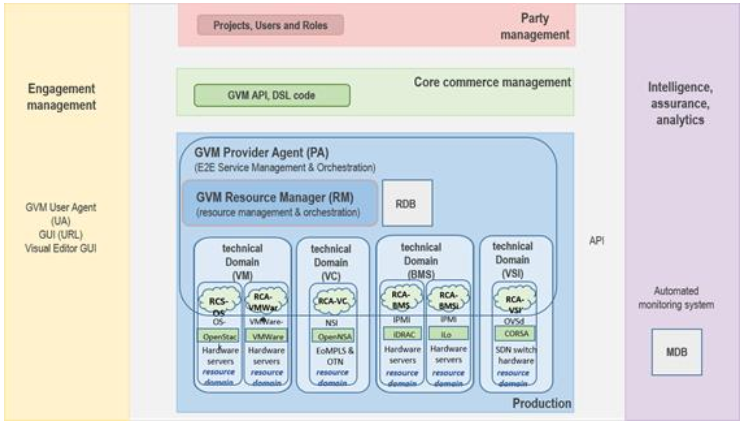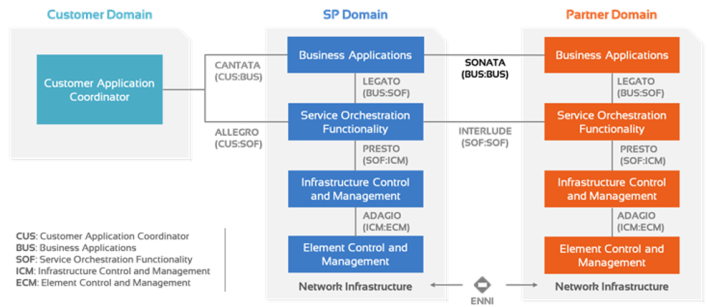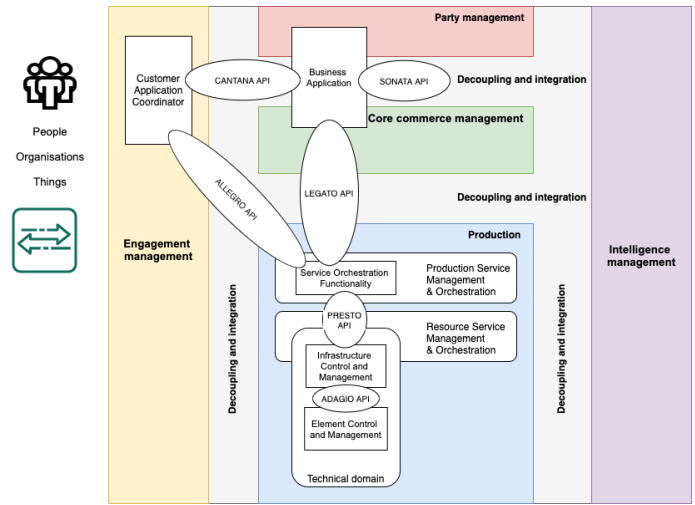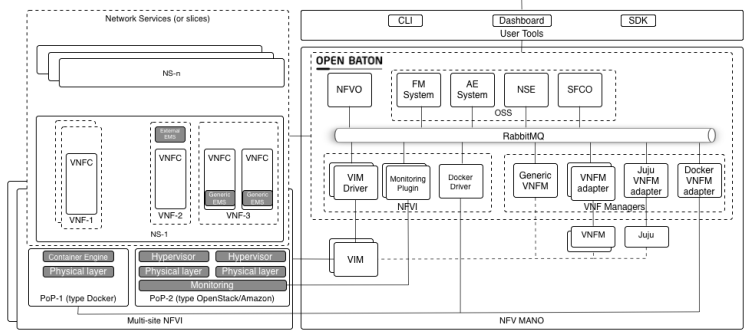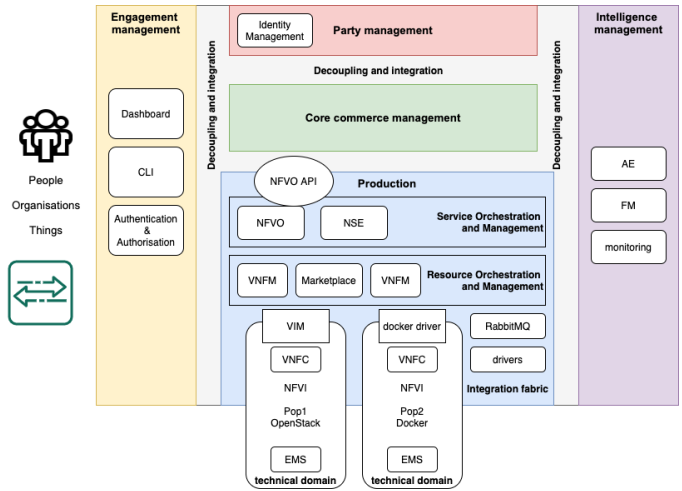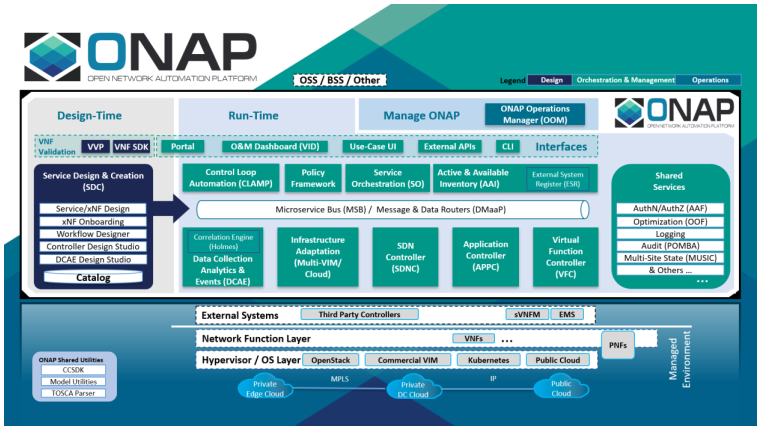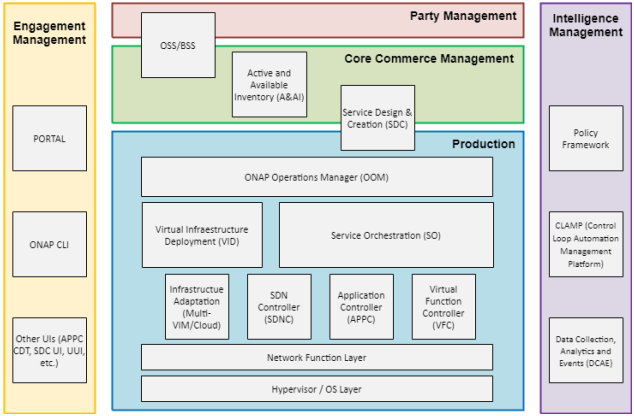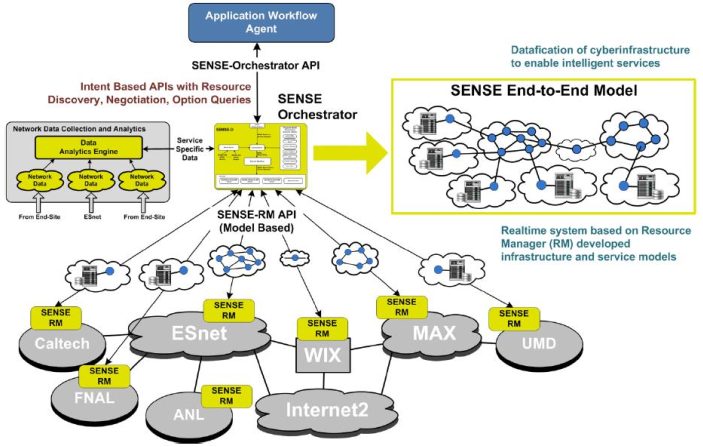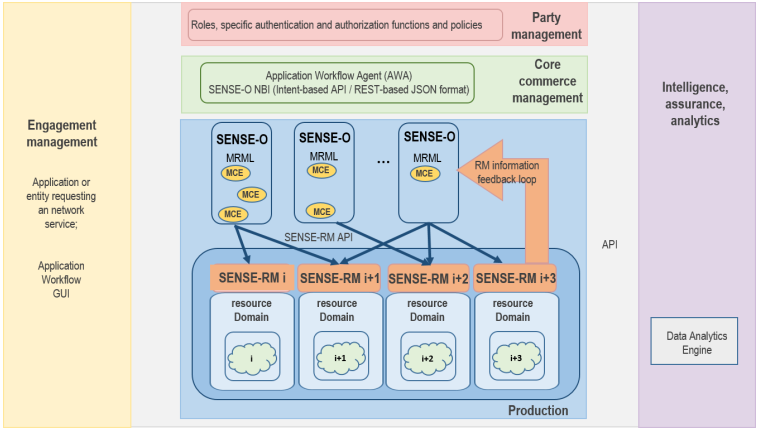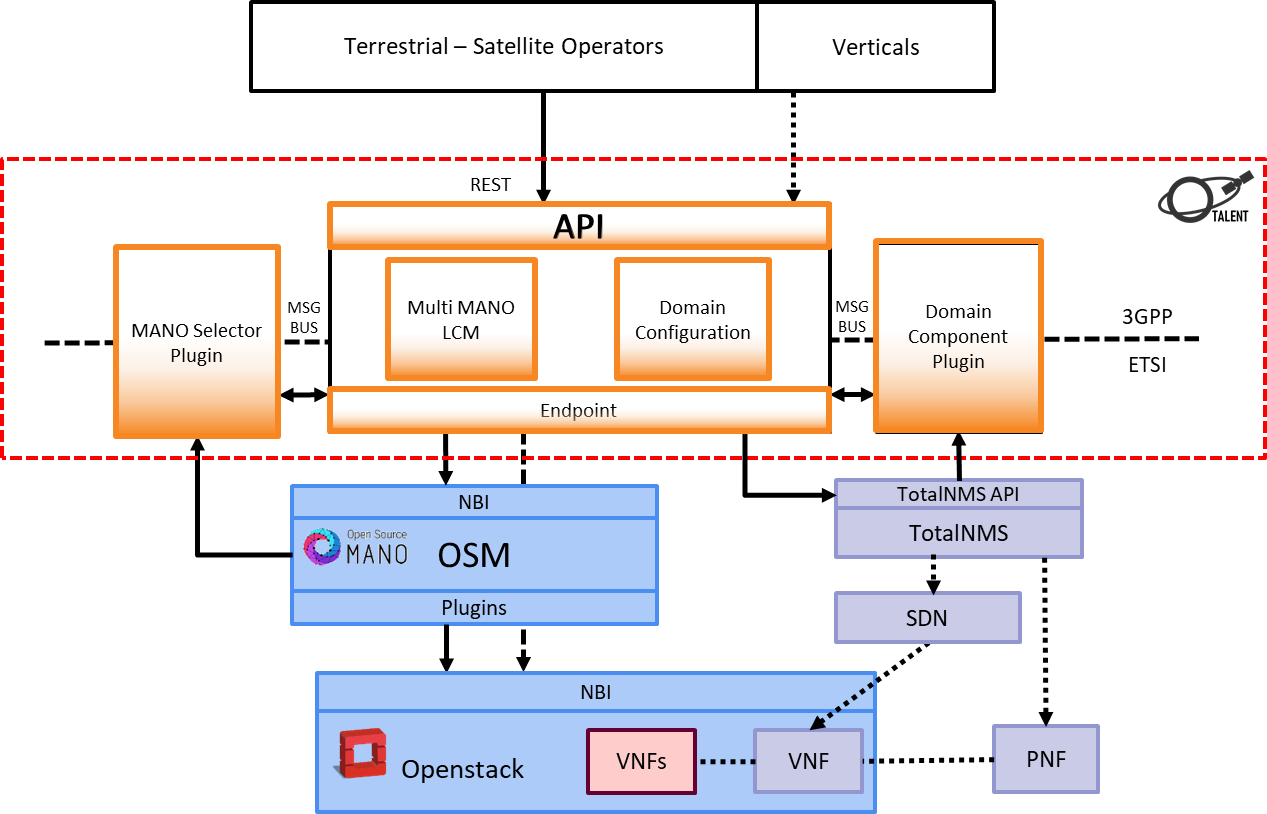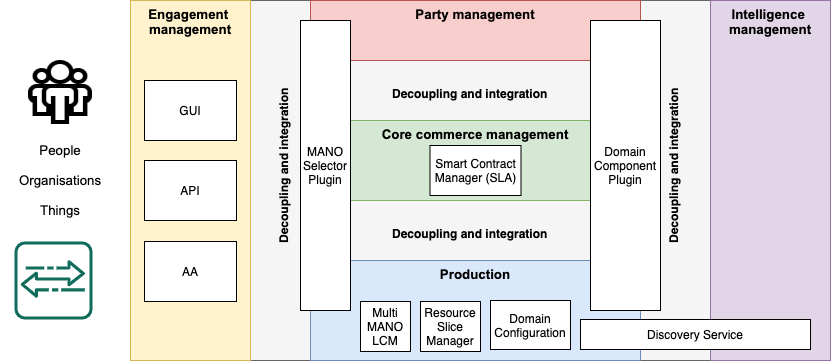NREN Architectures
Analysing NREN architectures from an orchestration, automation and virtualisation (OAV) point of view using a common reference architecture helps align efforts, and find similarities in the way different functionalities and components are implemented, which in turn facilitates potential collaboration between organisations and future interoperability. In pursuit of this goal, the GN4-3 Network Technologies and Services Development Work Package (WP6), Network Services Evolution & Development task (T2) selected the TM Forum Open Digital Architecture (ODA) as a reference blueprint architecture that can be used for such cross-comparison. The rationale for that choice is described in Deliverable D6.6: Transforming Services with Orchestration and Automation and in the White Paper: OAV Architectures.
MARnet
MARnet OAV Architecture Analysis
GÉANT Whitepaper November 3rd, 2025
(pdf)
This document maps MARnet’s Operations and Business Support System (OSS/BSS) to the TM Forum’s Open Digital Architecture (ODA) and analyses the mapping to provide a standardised view of the components and implementations of orchestration, automation and virtualisation within the NREN.
It highlights MARnet's strategic alignment with contemporary digital architecture standards and emphasises the critical need for automation within MARnet's operations to meet the growing demands of education and research activities. The analysis also identifies opportunities for further enhancement of MARnet's intelligence management capabilities through advanced technologies like machine learning and AI-capable tools, positioning MARnet to proactively adapt to emerging technological trends.
CARNET
CARNET OAV Architecture Analysis
GÉANT Whitepaper June 16, 2021
(pdf)
GÉANT Whitepaper December 31, 2024
(pdf)
The document analyses the mapping of the CARNET architecture to the TM Forum’s Open Digital Architecture aiming to provide a standardised view of the components and implementations of orchestration, automation and virtualisation within the NRENs.
This document presents an updated version of the mapping of the components implementing the CARNET network observability and other main components into the ODA functional blocks. It highlights the evolution and updates made to these components over the past three years. Since the publication of the first version, several components have been enhanced and updated to align with needs, ensuring improved functionality and scalability.
CYNET
CYNET OAV Architecture Analysis
GÉANT Whitepaper December 9, 2020
(pdf)
GÉANT Whitepaper December 31, 2024
(pdf)
This document undertakes an analysis of CYNET’s network architecture components. It does so by comparing the current status to the TM Forum’s Open Digital Architecture (ODA), which is the reference architecture selected by the GN4-3 project’s Orchestration, Automation and Virtualisation (OAV) focus group within the Network Technologies and Services Development Work Package. The analysis can help to further develop the potential for CYNET to be compatible with future OAV multi-domain processes and workflows throughout Europe.
CYNET is Cyprus' National Research and Education Network. It provides a network infrastructure for the Cypriot Research and Education Community and connects educational and research institutions. CYNET-II, the national backbone of CYNET, is connected to the European backbone GÉANT which is part of the world-wide community of research and education networks. This document updates the previous analysis of the components of CYNET’s network management system architecture, focusing on the Orchestration, Automation and Virtualisation (OAV) aspects of its implementation. The NREN community can use this analysis to compare their own components and approaches with those of CYNET, and may find similarities that inspire them to work together on their journey towards OAV.
GÉANT
GÉANT OAV Architecture Analysis
GÉANT Whitepaper November 28, 2022
(pdf)
The document analyses the mapping of the GÉANT network architecture to the TM Forum’s Open Digital Architecture (ODA). This analysis is one of a series of such documents aiming to provide a standardised view of the components and implementations of orchestration, automation and virtualisation (OAV) within the community.
This document maps GÉANT’s current Operations and Business Support Systems (OSS and BSS) to the TM Forum (TMF) [TMF] Open Digital Architecture (ODA) [ODA] reference architecture to demonstrate the flexibility and the benefits that the ODA model offers.
A reference architecture like ODA supports the transition from traditional work organisation based on manual work and procedures to a model where services are automatically provisioned and orchestrated. The mapping of the tools in use at GÉANT to functional blocks shows, how ODA can be used as a framework to understand architectures in situations where environmental complexity and independent growth have led to dependencies that are not easy to identify. This helps manage and guide the digital transformation process in complex organisations such as GÉANT and other Research and Education (R&E) entities
GRNET
GRNET OAV Architecture Analysis
GÉANT Whitepaper January 24, 2022
(pdf)
The document analyses the mapping of the GRNET (Greek Research and Technology Network) architecture to the TM Forum’s Open Digital Architecture aiming to provide a standardised view of the components and implementations of orchestration, automation, and virtualisation for network management services.
The Greek National Research and Education Network (GRNET) provides a network infrastructure for the Greek research and education community, and connects educational and research institutions. It also provides a variety of additional services, including cloud services, high performance computing, Firewall-on-Demand, Firewall-as-a-Service, sound-, video- and teleconference-services, and a large collection of digital services for the educational community. In May 2019 GRNET participated in a GÉANT survey [SURVEY2019, SURVEY-RESULTS] and, as part of that, performed an analysis of existing systems and architecture components in the context of automation, virtualisation, and orchestration. Based on this analysis GRNET architectural components have been identified and matched to the TMForum Open Digital Architecture (ODA) functional blocks.
HEAnet
HEAnet OAV Architecture Analysis
GÉANT Whitepaper October 20, 2021
(pdf)
The document analyses the mapping of the HEAnet architecture to the TM Forum’s Open Digital Architecture, aiming to provide a standardised view of the components and implementations of orchestration, automation, and virtualisation within the National Research and Education Networks (NRENs).
PIONIER
PIONIER OAV Architecture Analysis
GÉANT Whitepaper February 4, 2022
(pdf)
The document analyses the mapping of the network architecture of the Polish Optical Internet (PIONIER) - a nationwide broadband optical network for e-science to the TM Forum’s Open Digital Architecture (ODA). This analysis is one of a series of such documents aiming to provide a standardised view of the components and implementations of orchestration, automation and virtualisation (OAV) within the NRENs.
In this document, the team reports on an analysis of the different functional aspects of the PIONIER network architecture, managed by the Poznań Supercomputing and Networking Centre (PSNC). The document focuses on PSNC networking activities, and analyses how different components map to the ODA reference model. The mapping highlights the main characteristics and capabilities of the current PIONIER network architecture, and how they fit into the main functional domains of ODA. The analysis was carried out by the PSNC network architects supported by the WP6T2 team.
SURFnet
SURFnet OAV Architecture Analysis
GÉANT Whitepaper December 9, 2020
(pdf)
This document analyses the mapping of the SURFnet architecture to the TM Forum’s Open Digital Architecture, as part of the GN4-3 project’s ongoing activity in the Network Technologies and Service Development’s work package to provide a standardised view of the components and implementations of orchestration, automation and virtualisation within the NRENs. Overall, it can be concluded that the SURFnet OAV architecture, although independently developed, is very much aligned to the ODA’s core principles and design concepts.
NETDEV Architectures
Argus
Argus OAV Architecture Analysis
GÉANT Whitepaper June 30, 2023
(pdf)
This document analyses the mapping of the Argus architecture to the TM Forum’s Open Digital Architecture (ODA), aiming to provide a standardised view of the components and implementations of orchestration, automation and virtualisation (OAV) within the Argus deployment at the Norwegian National Research and Education Network (NREN), Sikt.
Argus is an open-source tool for Network Operation Centres and service desks to aggregate incidents from all their monitoring applications into a single, unified dashboard and notification system. This document analyses the mapping of the Argus architecture to the TM Forum’s Open Digital Architecture, aiming to provide a standardised view of the components and implementations of orchestration, automation and virtualisation within the Argus deployment at Sikt, the Norwegian NREN.
NMaaS
NMaaS OAV Architecture Analysis
GÉANT Whitepaper January 05, 2022
(pdf)
The document analyses the mapping of the NMaaS (Network Management as a Service) architecture to the TM Forum’s Open Digital Architecture aiming to provide a standardised view of the components and implementations of orchestration, automation and virtualisation for network management services.
PMP
PMP OAV Architecture Analysis
GÉANT Whitepaper December 21, 2023
(pdf)
This document analyses the mapping of the PMP (Performance Measurement Platform) service architecture to the TM Forum’s Open Digital Architecture to provide a standardised view of the orchestration, automation and virtualisation components and implementations within the service.
The PMP service is a platform consisting of central components and a set of small nodes that perform regular active performance measurements towards several Measurement Points (MPs) located in the core of the GÉANT network, and operated by the GÉANT network operations centre. The PMP operational team maintains an instance of the Maddash dashboard [PMD] for visualising performance testing between the PMP service instances in NRENs and GÉANT PoPs.
PMP incorporates different tools for different functionalities and components. Using a common reference architecture to analyse this network monitoring platform from the point of view of orchestration, automation, and virtualisation helps enables a better understanding of the system, identifying commonalities in the way these various functionalities and components are implemented, as well as a cross-comparison with other platforms, which in turn promotes future interoperability and integration.
SPA
SPA OAV Architecture Analysis
GÉANT Whitepaper May 26, 2021
(pdf)
The Service Provider Architecture (SPA) [SPAW] is a service management platform that is based on the TM Forum Open Digital Framework. Its development is continued from the previous generation of the GÉANT project (GN4-2) and its Self-Service Portal graphical user interface (SSP GUI) is used for the service order management process of the GÉANT Connection Service (GCS) [SSPM20]. The SPA solution can be used as the basis for the development of a digital platform and to manage the lifecycle of any type of service, including networking, trust and identity or security services.
While all components of the SPA follow the principles of the building blocks architecture, the solution also incorporates other aspects of OAV design principles, such as:
- Ability to compose services and resources.
- Abstract, technology-agnostic modelling of all resources and services.
- Distinction between products, customer-facing and resource-facing services.
- Support for both physical and virtual networks.
- Ability for east-west integration with systems from other domain.
Other Use Cases
5G
5G OAV Architecture Analysis
GÉANT Whitepaper May 26, 2021
(pdf)
5G is a mobile technology that is addressing, by design, a broad range of requirements: very high data rates, very low latency, low energy consumption, high scalability, improved connectivity and reliability, and improved security [FGPPP18], [FGPPP20]. The 5G specifications focus on serving mobile operator needs in terms of extreme mobile broadband services and include several features to support vertical industries in terms of enablers for an industrial Internet of Things (IoT) and Ultra Reliable Low Latency Communications (URLLC) [FGPPP20]. Within the 5G system, end-to-end (E2E) network slicing, service-based architecture, Software-Defined Networking (SDN) and Network Functions Virtualisation (NFV) are seen as the fundamental pillars of the 5G architecture.
EOSC
EOSC OAV Architecture Analysis
GÉANT Whitepaper May 26, 2021
(pdf)
The European Open Science Cloud (EOSC) initiative [EOS20] is part of the European Commission’s effort to increase the competitive digital economy in Europe. The main idea of the initiative is to support Open Science, which in turn will enable a more agile approach to innovation. The main goal of EOSC is to provide researchers from different research fields with the means necessary not only to conduct research, but also to make their research outcomes open to the wide community. Thus, in essence, the end goal is to create a cloud-based virtual environment that will provide a number of open services that can be used to store, manage and analyse research data. Six different actions are being implemented in parallel to achieve this goal, described in the EOSC implementation roadmap [ETS20]. One of the action lines focuses on the architecture of the virtual environment, which should achieve a federated, seamless view of all available research infrastructures and services built on top.
EOSC technical architecture – interactions between
thematic and common services
ETSI GANA
ETSI GANA OAV Architecture Analysis
GÉANT Whitepaper May 26, 2021
(pdf)
One of the main requirements for future architectures and digital service providers is to be able to transform all manual management of network and services into Automated and Autonomic Management & Control (AMC) so that the system dynamically responds to the changing environment. This behaviour is also known as autonomics and is the main focus of the Generic Autonomic Network Architecture (GANA) [GANA16]. In other words, the GANA reference model provides a way to build autonomic architecture using a generic AMC framework that can integrate with any type of network management architecture.
The ETSI Network Technologies (NTECH) Autonomic network engineering for the self-managing Future Internet (AFI) working group leads the AMC standardisation efforts that will transform the traditional networking environment into a smart and intelligent network with a number of self-* features including self-healing, self-configuration, self-optimisation and others.
AFI GANA reference model
ETSI OSM
ETSI OSM OAV Architecture Analysis
GÉANT Whitepaper May 26, 2021
(pdf)
ETSI Open Source MANO (OSM) [EOSM20] is a management and orchestration solution that complies with the ETSI NFV architectural framework. While it offers its own Virtual Infrastructure Manager (VIM), it also supports many third-party VIMs such as OpenStack, VMware vCloud and VIO, Amazon Web Services, Azure and Google Cloud and, since release seven, also Kubernetes. This last integration allows the deployment of more than 20,000 pre-existing production-ready Kubernetes applications, with no need of any translation or repackaging, which are added to the steadily increasing number of Virtual Network Functions (VNFs) commercially or freely available.
ETSI NFV reference architectural framework
ETSI ZSM
ETSI ZSM OAV Architecture Analysis
GÉANT Whitepaper May 26, 2021
(pdf)
The European Telecommunications Standards Institute (ETSI) Zero-touch network and Service Management (ZSM) working group has the aim of defining a universal framework to enable end-to-end zero-touch service automation involving different management domains. The proposed framework [EZSM] focuses on closed-loop service automation based on monitoring and high-quantity data collection, to which machine learning and artificial intelligence procedures apply. The end-to-end automation procedures considered by ETSI ZSM comprise all operational processes and tasks, including delivery, deployment, configuration, lifecycle management, assurance, optimisation and finalisation. It aims to provide 5G E2E network slicing and management capacity, ideally with 100% automation or zero human intervention, and aims to be general enough to integrate current and future networks and services.
ETSI ZSM reference architecture
GVM
GVM OAV Architecture Analysis
GÉANT Whitepaper May 26, 2021
(pdf)
The Generalized Virtualization Model (GVM) describes an architecture that supports managing the lifecycle of different network topologies as virtual network slices over a physical infrastructure in a fully automated fashion. These virtual networks are environments where abstracted virtualised objects, called resources, can be defined, instantiated and arranged to create application-specific insulated networks and services. This process is performed via a graphical user interface (GUI) and without the need for human intervention from network operations or engineering teams.
Virtualisation, management and user control layers in GVM
MEF LSO
MEF LSO OAV Architecture Analysis
GÉANT Whitepaper May 26, 2021
(pdf)
Metro Ethernet Forum Lifecycle Service Orchestration (MEF LSO) [MSOS16] is a layered abstraction architecture defined to build the systems for coordinated management and control across all network domains responsible for delivering an end-to-end connectivity service. LSO provides interoperable automation of operations over the entire lifecycle of Layer 2 and Layer 3 connectivity services, as shown in Figure B.2. This includes design, fulfilment, control, testing, problem management, quality management, billing & usage, security, analytics and policy capabilities. The architecture specifies high-level functional requirements, the functional management entities and the management interface reference points (logical points of interaction) between them.
LSO reference architecture
Open Baton
Open Baton OAV Architecture Analysis
GÉANT Whitepaper May 26, 2021
(pdf)
Open Baton [OB20] is an open source platform developed by Fraunhofer FOKUS and the Technical University of Berlin that enables implementation of an NFV environment based on the ETSI NFV MANO architecture framework [ETSINFVSPEC].
Open Baton uses an agile development process to provide a customisable network service orchestration framework based on the MANO NFVO. The framework supports multiple sites that provide heterogeneous Network Function Virtualisation infrastructure. Using the generic Virtual Network Function Manager (VNFM) the architecture can manage a large set of different VNFs.
Open Baton architecture release 5
ONAP
ONAP OAV Architecture Analysis
GÉANT Whitepaper May 26, 2021
(pdf)
The Open Network Automation Platform (ONAP) [ONAP20] arose after the combination of two Network Function Virtualisation (NFV) orchestration and management initiatives: Enhanced Control, Orchestration, Management & Policy (ECOMP), led by AT&T, and Open Orchestrator (Open-O), led by China Mobile.
ONAP architecture
SENSE
SENSE OAV Architecture Analysis
GÉANT Whitepaper May 26, 2021
(pdf)
SDN for End-to-end Networked Science at the Exascale (SENSE) [SEN20], [MON18] was developed in a research project with the goal to provide a network architecture that will facilitate the rapid deployment of smart network services in support of science applications. The main contributors to this project are ESnet/Lawrence Berkeley National Laboratory, California Institute of Technology, Fermi National Accelerator Laboratory, Argonne National Laboratory and the University of Maryland College Park.
The architecture was developed with next-generation big data/exascale science workflows in mind that will require intelligent network services in cloud computing, AI and machine learning. The idea is to support scientists and their science workflows with a system that will automatically build virtual guaranteed networks over large-scale distributed storage and computing infrastructures without any human intervention and without the static non-interactive network infrastructures in place today.
SENSE architecture
TALENT
TALENT OAV Architecture Analysis
GÉANT Whitepaper May 26, 2021
(pdf)
Terrestrial Satellite Resource Coordinator (TALENT) is a coordination tool which provides end-to-end services over satellite domain, radio system, cloud and Mobile Edge Computing (MEC) resources [TAL19]. It provides a single and easy-to-use point of interaction for all stakeholders involved in the ecosystem, such as terrestrial and satellite operators as well as different 5G verticals. TALENT is completely in line with 3GPP and ETSI definitions, extending them towards satellite systems. The original idea of TALENT is based on the definition of hierarchical and distributed orchestration [HDO17], where an overarching orchestrator is able to manage and coordinate several independent domains (satellite, radio and cloud). It is assumed that a domain manager (DM) exists in each domain that can work with the resources of this domain. In this sense TALENT becomes a light, scalable and efficient solution, agnostic to elements of domains coming from various vendors.
References
[EOS20] European Open Science Cloud (EOSC) https://ec.europa.eu/research/openscience/index.cfm?pg=open-science-cloud
[EOSM20] Open Source MANO website https://osm.etsi.org/
[ETS20] EOSC Technical Specification proposal, January 2020 https://confluence.egi.eu/display/EOSCDOC/Federation+services
[ETSINFVSPEC] ETSI standards for NFV: specifications within the NFV Architecture Framework https://www.etsi.org/technologies/nfv
[EZSM] ETSI GS ZSM 002 V1.1.1, Zero-touch network and Service Management (ZSM); Reference Architecture, August 2019 https://www.etsi.org/deliver/etsi_gs/ZSM/001_099/002/01.01.01_60/gs_ZSM002v010101p.pdf
[FGPPP18] 5GPPP Architecture Working Group View on 5G Architecture, v2.0, Jan 2018 https://5g-ppp.eu/wp-content/uploads/2018/01/5G-PPP-5G-Architecture-White-Paper-Jan-2018-v2.0.pdf
[FGPPP20] 5GPPP Architecture Working Group View on 5G Architecture, v3.0, Feb 2020 https://5g-ppp.eu/wp-content/uploads/2020/02/5G-PPP-5G-Architecture-White-Paper_final.pdf
[GANA16] ETSI, GANA – Generic Autonomic Networking Architecture, White paper no. 16, October 2016 https://www.etsi.org/images/files/ETSIWhitePapers/etsi_wp16_gana_Ed1_20161011.pdf
[HDO17] J. S. Choi, “Hierarchical Distributed Orchestration Framework for Multi-Domain SDTNs”, Journal of Optical Communication and Networking, vol. 9, no. 12, pp. 1125-1135, 2017 https://www.osapublishing.org/abstract.cfm?uri=jocn-9-12-1125
[MON18] I. Monga, C. Guok, J. MacAuley, A. Sim, H. Newman, J. Balca, P. deMar, L. Winkler, T. Lehman, X. Yang, SDN for End-to-end Networked Science at the Exascale (SENSE), 2018 IEEE/ACM Innovation the Network for Data-Intensive Science (INDIS), Dallas, TX, USA
[MSOS16] MEF Service Operations Specification MEF 55 Lifecycle Service Orchestration (LSO): Reference Architecture and Framework, March 2016 https://www.mef.net/wp-content/uploads/2016/03/MEF-55.pdf
[OB20] Open Baton platform http://openbaton.github.io/documentation/
[ONAP20] ONAP Platform https://www.onap.org/
[PMD] https://pmp-central.geant.org/maddash-webui/
[SEN20] SDN for End-to-end Networked Science at the Exascale, (SENSE) http://sense.es.net/
[SPAW] Service Provider Architecture Wiki Page. https://wiki.geant.org/display/NETDEV/SPA
[SSPM20] GN4-3, WP6 T2, D6.6 Transforming Services with Orchestration and Automation, November 2020. https://www.geant.org/Projects/GEANT_Project_GN4-3/GN43_deliverables/D6.6-Transforming_Services_with_Orchestration_and_Automation.pdf
[SURVEY2019] GÉANT WP6, Orchestration, Automation and Virtualisation in NRENs, https://wiki.geant.org/display/NETDEV/WP6+Events?preview=/123792049/133766032/WP6_OAV_NREN-Survey.pdf
[SURVEY-RESULTS] GÉANT WP6, Orchestration, Automation and Virtualisation (OAV), The Survey Rsults, by Topic, https://wiki.geant.org/display/NETDEV/WP6+Events?preview=/123792049/123793662/2019-05-09-OAV-Survey-Results-by-Topic.pdf
[TAL19] H. Khalili, P. S. Khodashenas, D. Guija and S. Siddiqui, “Introducing Terrestrial Satellite Resource Orchestration Layer”, 21st International Conference on Transparent Optical Networks (ICTON), 2019, pp. 1–4, doi: 10.1109/ICTON.2019.8840562 https://ieeexplore.ieee.org/abstract/document/8840562/











